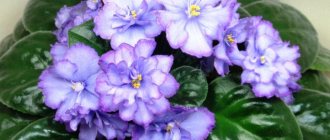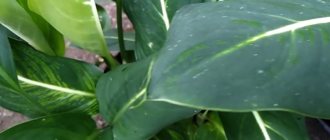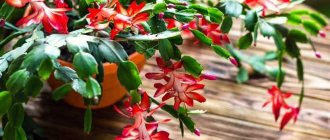Decorative akalifa is distinguished by its crimson color and oblong shape of inflorescences. With its unusual appearance and flowering, the ornamental shrub has acquired the popular name - foxtail flower. In some countries it is known as “fire cat tail” or simply “cats tails”. The beautiful name and exotic decorative appearance have won a special place in the hearts of flower growers around the world. If you also like this flower, then you should learn more about the features of growing it at home.
Briefly about care
| Type of agricultural operation for caring for akalifa | Description of conditions and actions |
| Watering and air humidity | abundant watering from spring to autumn, the flower is watered 2-3 times a week, in winter a little less often; Do not allow the soil to dry out |
| Lighting organization | diffused sunlight; Avoid exposure to direct sunlight |
| Maintaining a rest period | has no dormant period, but growth and flowering may be delayed in the winter months |
| Creating temperature conditions | stops growing at a temperature of 18 °C, the optimal temperature is from 18 to 25 °C. |
| Trimming | as needed; inflorescences and dry branches are removed |
| Making soil mixture | peat, sand, turf and leaf soil in equal proportions (1:1:1:1) |
| Fertilizer application | From March to August it is necessary to fertilize with a solution of complete mineral fertilizer |
| Transfer | young akalifa needs an annual transplant, an adult - once every 3-4 years |
| Chemical treatment | fungicides for fungal diseases and leaf spot; insecticides against spider mites, mealybugs. |
Spring housewarming
Young akalifa grows rapidly, so transplanting into a larger pot occurs annually in early March. Do not cover the drainage hole with anything: the plant gets sick due to waterlogging. When replanting, add 3 cm of drainage made of fine crushed stone, expanded clay, and foam chips.
The older the plant becomes, the less often it needs replanting, no more than once in 3 years. In large specimens sitting in large containers, the surface layer of the soil simply changes.
Since foxtail is watered frequently, the soil needs to be loose, allowing the roots to breathe. Take equal parts of peat, coarse river sand, leaf humus and turf soil. Any commercially available slightly acidic soil will do.
Description of the plant
Foxtail (acalipha hispida) is a tropical guest in our latitudes. The flower's homeland is Southeast Asia and Australia. The plant of the hispid variety is an ornamental-leaved and ornamental-flowering perennial shrub of the Euphorbiaceae family.
Akalifa cats tails are creeping hanging plants grown in hanging flowerpots and pots. Flower growers value the decorative features of the flower and carefully monitor the shape of the shrub.
Ornamental shrub with ovate leaves pointed at the ends. It is distinguished by earring-shaped inflorescences with a bright scarlet color, causing an association with a fox or cat's tail.
Types of flower with photo
Akalilife is divided into two main groups:
- The first includes species with bright red fluffy inflorescences. Their length can reach 50 cm.
- The second group is red, bronze-green and red-brown flowers. They are rather inconspicuous, but they grow very quickly.
The genus Akalifa includes 454 species. More details about this can be found here.
Popular varieties
Next, you can read the description of popular flower varieties and look at their photos.
Vilkez
This subshrub is capable of growing up to 3 m. Straight shoots are reddish in color . Large leaves have a greenish-bronze tint. The inflorescences are small and inconspicuous.
Bristly haired
Features: Deep green leaves. Red ears grow up to 50 cm. There is a subspecies with white inflorescences.
Indian
This is a low variety of half-meter annual. The flowering period lasts from July to September.
South
The annual has thin roots and a ribbed branching stem . It has large fluffy ears.
Godsefa
This hybrid has inconspicuous flowers with large, toothed leaves. Bronze greenery is combined with bright copper-red inflorescences.
oak leaf
This variety is cultivated using the hanging method. Lush shrubs grow up to 25 cm in height. The diameter of the inflorescence does not exceed 3 cm, the leaves are small and bright green in color.
Hispida
The indoor representative of Akalifa has furry inflorescences up to 50 cm long . The most common color is purple. The peculiarity of this species is that it blooms throughout the year.
Akalifa can be grown both in open ground and in garden pots in apartment conditions.
What you should know before buying indoor akalifa
Imagine in advance where you will place the flower. Hanging pots are most often used, since branches and flowers grow and droop profusely. If you have small children or pets, make sure the planter is out of their reach. The plant can cause health problems if it enters the stomach or mucous membranes. Read more about this below.
| Mature plant size | depending on the type from 30 to 150 cm: high (above 100 cm), low (10-50 cm), hanging (below 10 cm) |
| Lifespan | up to 7 years, but some species in indoor conditions, in order not to lose their decorative effect, it is better to update annually |
| Bloom | bright pink flowers in the form of rocking earrings; flower size from 8 to 50 cm |
| Aroma | not clearly expressed |
| Safety | poisonous; gloves are needed when working with the plant |
| Difficulty of care | quite unpretentious, but there are nuances |
| Uniqueness | rare plant |
| Where can I buy |
|
Opinions about the difficulty of caring for crops among gardeners vary. Experienced people say that the plant is very easy to grow and maintain. But for beginners, caring for a flower can bring a lot of trouble, so take this fact into account before purchasing a plant.
Diseases and pests
If spots appear on the leaves of Akalifa, it is most likely affected by a fungus. For fungal diseases, plants are treated with a fungicide.
If leaves are limp, watering should be adjusted. The reason may be overdrying or waterlogging of the earthen clod.
Scale insects, thrips, aphids, and scale insects are typical flower pests. Another enemy of Akalifa is the spider mite, as well as the whitefly. To protect against pests, the plant is sprayed with insecticides, for example, you can use Aktara, Fitoverm.
When working with akalifa, be careful, all parts of the plant contain toxic substances! The flower secretes milky white juice, which is highly irritating to the mucous membranes and skin. In especially severe cases, allergic reactions and Quincke's edema are possible. Any work with this plant is carried out only with gloves. When finished, be sure to wash your hands. Place the flower in places inaccessible to children and animals.
However, as often happens, poisonous plants also have medicinal properties. Residents of Australia and Polynesia use the plant to treat bronchitis, pneumonia, asthma, and the gastrointestinal tract. Scientists have proven that when indoors, akalifa, releasing phytocindes, cleans the air of bacteria such as staphylococcus and streptococcus.
Plant energy: can akalifa be kept in the house?
Akalifa, growing in a home flower garden, will protect household members from depression, scandals, and a melancholic mood. A flower, like a lightning rod, absorbs psycho-emotional outbursts. Negative emotions seem to be purified in a field of flowers.
If you give up and doubts prevent you from starting an important task, stand next to Akalifa and your self-doubt will pass. Prudent parents place a flower near the student’s desk. After all, among other things, the plant relieves laziness, makes a person more collected, and increases efficiency.
If you belong to the category of people “of everything and more” (which does not always have a positive effect on your health and psychological state), a green pet will help you reconsider your attitude towards life and balance the concepts of “want” and “need”.
It is not for nothing that Akalifa is called a “warm flower”, because its owner will never suffer from the cold. This is a real godsend for people who are cold or allergic to cold.
If you stay near Akalifa for at least 10 minutes a day, the functionality of internal organs will be stimulated and the general condition of the body will improve.
Attention! Do not expect the manifestation of beneficial properties and positive energy from a sick, lethargic or dried flower.
Transplanting a plant
The main difficulty is that for a tropical guest it is necessary to create suitable conditions in our climate. However, if the necessary parameters are observed, the plant develops well and pleases its owner with fiery inflorescences all year round.
With proper care and living conditions, it has no rest period. During the winter months, growth and flowering may be delayed due to short daylight hours.
The flower can be replanted in warm spring (April or May). A young flowerpot is replanted every year, an adult plant - once every 3-4 years. The substrate for replanting can be purchased in specialized stores or prepared independently by taking sand, peat, turf and leaf soil in a ratio of 1:1:1:1.
Foxtail contains a poisonous milky sap that can cause skin irritation. Therefore, when working with it, always protect your hands with gloves. Also make sure that your children and pets do not have the opportunity to come into contact with the planter.
What types and varieties to choose?
The most famous eremurus include:
- Eremurus powerful (E. robustus) is the tallest species, reaching up to 150-300 cm in garden conditions. It is distinguished by white or pale pink flowers. Inflorescences (60 cm) on long stalks appear in May. The species is not completely frost-resistant, so it should be covered with a layer of leaves before winter. The leaves begin to grow early, so they are subject to freezing and should be protected from spring frosts.
- The Himalayan Eremurus (E. himalaicus) is a popular choice for gardeners to grow and is especially elegant in its snow-white color.
- Narrow-leaved Eremurus (E. stenophyllus) is the third popular species; it is lower (up to 1 m) and is distinguished by exceptionally abundant and colorful flowers.
- The latest, in July-August, Eremurus Olga (E. olgae) blooms. Peduncles grow up to 2 meters, the flowers are pink with a burgundy stripe.
Among professional breeders, 2 noble varieties of Eremurus Isabella (E. x isabellinus) are highly valued:
- “Cleopatra” Cleopatra – exotic dark orange;
- “Pinokkio” Pinokkio – yellow-orange.
Elegant hybrids are also prized:
- white “White Beauty” White Beauty;
- salmon “Romance” Romance.
These are plants that will easily change the appearance of any flower bed and will delight you for many years!
Temperature and light
In our latitudes, akalifa ampelous requires special care at home, which includes maintaining optimal temperature and light. Acalypha is a heat-loving plant. It must be kept indoors.
The flower does not tolerate temperature changes well, so you should not move it from place to place.
The optimal temperature is from 18 to 25 °C. It reacts painfully to the slightest drafts and stops growing at temperatures below 18 °C. When determining the location of the flowerpot in the house, it is extremely important to remember this feature.
Akalifa
Foxtail, like all tropical plants, loves bright sunlight. However, the flower easily gets burned from direct sunlight. Therefore, pots with akalifa should not be hung directly opposite the window glass. Place the flower in the brightest room in the house and hang it so that it receives indirect sunlight.
Photo gallery
You will have to come to terms with the southern habits of Akalifa if you want to decorate your home with this tropical “nettle”. Although it does not burn your hands, its juice, like that of many euphorbias, is mildly toxic. The plant has retained its love for the warm, humid climate of its native places, which differs sharply from the conditions of a modern apartment. By bringing a piece of subtropics into your home, you change its atmosphere and change yourself.
Watering and air humidity
It is also very important to ensure timely watering of the plant.
Foxtail loves frequent and abundant watering. The earthen clod must not be allowed to dry out.
In the summer, you need to water the flowerpot several times a week, in the afternoon, when the heat subsides. In winter - immediately after the top layer dries.
When propagating by akalifa cuttings, there is no need to water them, just spray them with warm water.
When caring for indoor plants, it is important to understand that harm can come from both a lack of water and flooding of flowers.
Green pets should only be watered with soft water. Rain, pond or river water is ideal. If this is not possible, then you need to use filtered water or obtained when the refrigerator freezes.
Tap water can also be adapted for irrigation. For this purpose, it is heated to a temperature of 50–60 °C, then left for a day in an open container. Before watering, pour the water into a clean container, as sediment remains at the bottom.
To water tropical plants, the water temperature should be 2-3 degrees above room temperature. Watering with cold water can lead to rotting of the root system and falling off of the inflorescences.
Air humidity is also important for a tropical flower. For foxtail it is no less than 50%.
Problems with maintaining a flowerpot may appear in winter, when indoor heating causes the air to become drier. To increase air humidity, using a household humidifier is indispensable. However, if you cannot get such an assistant, you can spray with soft water or use a pot with a double bottom and a peat moisturizer.
Another way to increase humidity is to group houseplants. However, in this case, there is a possibility of green pets being affected by gray mold and mutual infection from diseased plants.
Possible problems during cultivation
Improper care leads to loss of decorativeness and reduced flowering. All the mistakes that the grower made are reflected in the appearance of the plant:
- In poor lighting, the stems will become very elongated, the leaves will become smaller and turn pale.
- Yellowed falling leaves with dry tips will indicate that the room has dry air and insufficient watering.
- Slow growth and pale foliage indicates a lack of nitrogen fertilizers.
- Drafts and cold indoor air coupled with frequent watering can cause dark spots to appear on the leaves and a fungal infection.
Akalifa is rarely attacked by pests. But errors in care can cause infection with spider mites, aphids, and whiteflies.
How to fertilize
Plants receive nutritional minerals and organic substances from the soil through the root system. During the growth period, plants need nitrogen fertilizers, and during flowering - phosphorus and potassium fertilizers.
Micronutrient deficiency can cause the following changes:
- The leaves become pale green and gradually turn yellow. The process begins from the lower leaves, then covers the entire bush.
- The lower leaves acquire a turquoise tint, and brown or red-violet spots appear on them. Gradually this color spreads to the entire plant.
- Akalifa flowers fall off, but new ones do not appear.
- Flowers are absent or become very small.
- The plant is easily infected by fungi.
- The growth of roots and stem tips slows down.
- Young leaves curl and become crinkled to the touch.
Application in the garden
The extraordinary beauty and splendor of Eremurus make them an ideal candidate for decorating flower beds, especially those located in full sun. The strong stems courageously withstand strong winds, and the plants are resistant to prolonged exposure to the sun. All this makes them an ideal option for sunny gardens located on less fertile and dry soils.
It is not recommended to create compositions consisting only of eremurus, since they have a relatively short flowering period, after which the shoots and leaves are unattractive. Therefore, landscape designers usually combine species of the genus Eremurus with taller perennials that bloom until late summer, for example:
- lavender;
- rudbeckia;
- eryngium;
- helenium;
- roses.
When planning, you need to be careful - eremurus do not tolerate too close proximity to other plants with a developed root system. According to some sources, bulbous flowers will cause the least harm to it:
- lilies;
- gladioli;
- decorative garlic;
- irises.
The leaves of the plant begin to dry out already during the flowering period. Therefore, it should be planted at the back of the flower bed. A tall inflorescence will please the eye, and other plants will cover the drying leaves, and after the leaves dry, there will be an empty space.
The Eremurus flower is extremely impressive when cut, can be combined into colorful bouquets, and lasts a long time in a vase.
Akalifa propagation methods
Propagating indoor plants allows you to create a real home garden at a minimum cost. After all, you don’t need to spend money on a new flower or its seeds. Also, you will always find something to give to loved ones who share your passion for floriculture.
Akalifa flower can be propagated by two methods: seeds and vegetatively.
Seeds
This method is rarely used by indoor gardeners, since it requires maintaining temperature conditions and maintaining humidity in the room for 1–2 weeks.
Akalifa seeds are sown in early spring (March, April). For seed germination, a soil mixture of leaf soil and sand in a 1:1 ratio is required. Before planting, pots or boxes should be washed with boiling water and disinfected with an antiseptic solution - potassium pergamanate, 2% copper sulfate solution, formaldehyde. The soil substrate is doused with boiling water or fried.
After sowing the seeds, the pot is covered with glass or plastic film, which is lifted once a day for ventilation.
The optimal temperature for germination of akalifa seeds is 20–22 °C.
The soil should not dry out, but if this happens, it can be moistened with a spray bottle.
After the sprouts appear, they are planted in more nutritious soil with the addition of turf soil. Diving is necessary for the development of a strong root system of the plant.
Vegetatively
Akalifa is characterized by propagation by cuttings. Since propagating a flower by seeds indoors is long and difficult, most gardeners prefer vegetative propagation. For this method, parts of an already mature plant are used.
Vegetative propagation of Akalifa occurs by stem cuttings. The top of the stem with 2–3 developed leaves is cut off with a sharp knife directly below the leaf.
It is important to make sure that the cutting you cut does not have inflorescences or flower buds, otherwise the sprout will not take root.
After separation from the mother plant, the cuttings must be placed in water for 10–15 minutes. For planting, you need to prepare a substrate from a mixture of peat soil and sand (1:1).
The optimal rooting temperature for cuttings is about 20–21 °C.
An indoor greenhouse with bottom heating will help create ideal temperature conditions. Flowers grown in a greenhouse must be ventilated daily. You should not water the cuttings; instead, you should regularly spray them with warm water.
After the root system has appeared, the plant is planted in a pot using a soil composition of leaf soil, peat, turf soil and sand in a ratio of 2:1:1:1.
Akalifa bristly reproduces quickly by cuttings in spring. If the cuttings were cut at an unfavorable time of year, they should be placed in a solution of a growth stimulator before rooting. But even in this case, the rooting process will be longer.
Propagation of the Fox Tail flower
Reproduction is most often carried out by cuttings; in rare cases, planting is carried out using seeds:
- The cuttings should be about 8cm long.
They take root well and quickly take root in the sand. The temperature for normal rooting should be about 25 degrees. The plant needs to be constantly moistened. After the first buds and leaves appear, the flower can be transplanted to a permanent place. Such manipulations are recommended to be carried out in the summer. - Seeds are planted in the ground in early spring. This will require a mixture of peat and sand. After planting, the ground is covered with film. Periodically it needs to be moistened and ventilated. After two leaves appear, the seedlings are planted at a distance of 3-4 cm from each other.
Errors in care
Plant health problems begin with a lack of light, dry air, drying out soil, drafts and temperature changes. The depressed state of a flower can also be due to a lack of nutrients in the soil.
To determine the cause of the malaise, you need to check the plant for pests and soil moisture. You also need to remove the flower from the pot and check whether the roots are affected by parasites. If no pests are found, and the root system fills the entire bud in the pot, then the problem may be that the soil substrate is depleted and the plant needs to be replanted.
If everything is fine with the soil and roots, the problem is probably hidden in external factors. Try to compensate for the lack of lighting and air humidity.
If the plant's leaves turn yellow and fall off, the problem may be insufficient watering, low temperatures or drafts. Poor lighting or excess mineral fertilizers can be suspected of the disappearance of flowering. Flowers quickly wither due to dry air, lack of light or too high air temperature. Akalifa is also susceptible to fungal and bacterial infections.
You can visually evaluate the results of caring for an akalifa flower at home using a photo of the flower on the Internet. Healthy shrubs have a neat decorative shape, lush green leaves and bright scarlet spikelets of inflorescences.
Pests often cause pathological changes in the life of Akalifa bristlecone:
- Spider mites live on the upper and lower sides of leaves, shoots and branches. Leaves begin to fall prematurely. A thin transparent cobweb appears between the stems. Increased temperature and dry indoor air are favorable for the appearance of ticks. If the damage is minor, wash the leaves and stems thoroughly with soap and water. In case of severe infestation, treatment with insecticides or colloidal sulfur is necessary.
- Scale insects live in colonies on the underside of leaves, in leaf axils, on branches and young shoots. Parasites suck out the juice, causing the shoots to lag behind in growth, the leaves turn yellow and fall off. For mild damage, wipe the plant with a cotton pad soaked in soap, alcohol or kerosene solution. If significant, spray with insecticides.
The necessary conditions
Akalifa cannot be called picky, but it has clear requirements for both humidity and air temperature, and lighting.
Life in diffused light
Try to find the brightest possible place for the plant. In the shade, the color of the “Copper Leaf” will fade, and the inflorescences of the “Fox Tail” will decrease. In winter, additional lighting may be required in the evening hours. Do not keep akalifa in direct sun - this can cause burns and dry out of the soil.
The foxtail is most comfortable on an east or west window. If it is on the south side, shade the bush on sunny days. On the northern windowsill, the foxtail does not have enough natural light, the stems stretch out and the leaves turn pale, flowering occurs later, the shades of the “tails” are duller.
Expert opinion on Akalifa from Anna Primatova
Well-known blogger and experienced florist Anna Primatova from the Irkutsk region, the village of Yurty, Taishet district, shares her experience in selecting soil and replanting Akalifa foxtail hairy. Anna is an agronomist by training with a specialization in biotechnology and has been growing flowers for a very long time.
Akalifa bristle-haired
Having extensive experience, the expert insists on choosing acidic, moisture-absorbing soil and, to demonstrate replanting, chose loose peat soil with Ph 2.5. A plant from a pot 9 cm in diameter is transferred to an 11 cm container. A larger volume is not recommended and the author focuses on large drainage holes.
Akalifa pot
As you can see in the photo below, the plant has a very thin and sensitive root system, so it should be remembered that overdrying is detrimental to this species. Before replanting, you can remove the top layer of dry soil and lightly massage the roots below. However, be careful not to damage the root system, otherwise the flower will dry out the leaves.
Akalifa root system
Next, without a drainage layer, the grower places the root of the plant in the prepared pot and fills it with new soil. This method is called transplantation by transshipment method.
The expert informs that the bristle-haired type of Akalifa blooms all year round and does not require a dormant period. Therefore, you can cut a plant at any time, but you should wait for new shoots. Immediately after moving the plant, pruning cannot be done, as the plant must adapt and grow.
Akalifa transplant
After the transshipment procedure, Anna recommends placing the flowerpot in a warm place. The plant does not tolerate drafts.
For proper care, it is recommended to fertilize in spring and summer, regular watering, and remove faded tails that grow back. The fertilizer must contain nitrogen.
Akalifa flowering
Anna uses vermiculite and the greenhouse effect to root cuttings. The most favorable temperature for rooting is 20-25 °C and not lower than 15 °C. The expert states that Akalifa can be considered an unpretentious plant, if you take into account all the nuances of its content.
Landing
The unusual appearance and exceptionally intensive growth are not the only advantages of the plant. Under natural conditions, this flowering giant grows in mountain, steppe and desert areas. As a result, it is very resistant to lack of moisture and grows well on light, sandy, infertile substrates. In order for eremurus to grow well and delight with beautiful inflorescences, you need to choose the right place for them in the garden and plant them correctly.
How to choose good seedlings?
The correct choice of variety does not guarantee spectacular flowering if you do not take care of the good condition of the seedlings. Before purchasing, make sure that the roots are not moldy or broken. They must be healthy. The rhizomes have a characteristic shape - they resemble a small octopus. In fact, it is a thickened part of the shoot from which fragile branches extend radially.
High-quality rhizomes are clean, without dark spots, fungal deposits, branched, hard and fleshy, with branches spreading horizontally to the sides.
You need to buy rhizomes in late summer and autumn. They can be found in garden stores and online stores. Shopping at a garden center has an advantage: you can look at each specimen and choose the largest and most beautiful ones yourself. However, it is in online stores that we will find the widest selection of new interesting color varieties.
After purchasing, rhizomes should be planted as soon as possible; they do not tolerate storage well. When purchasing in the spring (storing in the refrigerator), it is better to soak the planting material for 2-3 hours and plant immediately.
Soil requirements
Eremurus is a rather demanding perennial that can be called capricious. On the one hand, it prefers dry, even desert places; on the other hand, it requires a significant amount of water during the flowering period. Thus, the ideal soil for Eremurus should be:
- perfectly drained;
- quite fertile;
- with a tendency to dry out during cold periods;
- reaction from slightly acidic to alkaline (pH 6-8).
You need to choose a planting site for Eremurus:
- warm;
- sunny;
- protected from cold wind;
- unshaded;
- protected from stagnant water.
If the soil in the garden is heavy and loamy, Eremurus are planted in raised beds with good drainage.
Landing
The best time to plant Eremurus in open ground is autumn, warm, sunny September. Whole seedlings are not planted, but only healthy, dormant rhizomes.
Planted in September before winter, they have time to take root and winter better.
The rhizomes are very fragile and require special care when placed in the ground and therefore require wide planting holes. Plant them deep enough so that the plants do not tip over under the weight of the inflorescences.
A hole is dug with dimensions:
- width – 40 centimeters;
- depth – 8-15 cm.
The optimal planting depth for Eremurus is 3 times the height of the rhizome.
Distance between plants: at least 50-90 cm.
The colder the climate, the deeper underground the roots should be located. In the Moscow region, Eremurus is planted to a depth of 10 cm, the root itself is sprinkled with a layer of soil of about 2-3 cm.
Planting Eremurus rhizomes:
- Before planting, the place under the eremurus should be dug up, loosened, enriched with humus, for example compost (a 10-liter bucket of compost per 1 square meter of soil is added). In the locking areas it is better to add a small mound.
- We dig holes. You should add 1-2 handfuls of good soil, preferably compost, to the bottom.
Attention! If the soil is clay, good drainage is necessary. To do this, we dig a fairly large hole (40 cm deep), pour 10-20 cm of crushed stone (gravel, pebbles) onto the bottom, then 10 cm of sand, then 10 cm of soil mixed with a large amount of sand. This will ensure a good outflow of water, the plant is afraid of stagnation.
- We place each rhizome in a separate hole, maintaining the appropriate distance between individual plants. The root is placed horizontally in the hole. Ideally, not a single root should be bent. During September-October, the main roots will sprout small roots, the plant will take root before winter. When planting, it is important to position the rhizome correctly, with the bud up (see photo). We fill the hole with soil mixed with sand.
- It is good to mark the planting sites with a peg so that during subsequent gardening work you do not accidentally damage the rhizomes.
- On top it is worth pouring an additional layer of mulch (compost) 10 cm high and 24-40 cm wide, which will provide the substrate with nutrients and protect it from the cold of the first winter.
Diversity of the Akalifa family
Akalifa belongs to the Euphorbiaceae family. Akalifa foxtail is just one of the varieties of this wonderful plant. Fox tail is a plant with long scarlet inflorescences, which includes acalypha hispida.
Akalifa bristle-haired or Fox tail (acalypha hispida)
Botanists count more than 400 varieties of plants of the akalipha family, among which there are ornamental, herbaceous plants, shrubs and even trees. Some species of akalifa are classified as endangered species.
Plantarium acalypha includes the following species:
Akalifa Wilks or Akalifa Wilkesiana (acalypha wilkesiana) Akalifa tricolor (acalypha tricolor) Akalifa Thai snow Akalifa Viginsi
Haitian acalypha (acalypha chamaedrifolia)
Akalifa Alba (acalypha alba)
Indian acalypha (acalypha indica)
Acalypha godseffiana
Southern acalypha (acalypha australis) white acalypha (acalypha hispida white margined)
Not all plants have decorative value, so the herbaceous southern acalypha is a weed. Flowering ampel plant varieties, as well as variegated acalyphs, are most valued by flower growers and gardeners.
| Classification of species | Name |
| Herbaceous | southern |
| Bush | Wilksa, Indian, Godsefa, Australian |
| Ampelous | Haitian, oakleaf, Alpha Alba, bristly-haired, Thai snow |
| Tree-like | Vilkisyan |
| Variegated | wilkesiana, tricolor, variegata, musaica |
In our latitudes, they prefer to breed mainly indoor varieties, but in warmer countries, garden akalifa is common. A garden plant is grown as a bush or ornamental tree.
| Most popular types | bristly hairy; Alpha Alba; Wilks; wilkesiana; tricolor; variegata; musaica |
| Edible species | indica; kiliyata; bipartite |
Some plant varieties have medicinal properties. In medicine, the poisonous milky juice of akalifa has found application in the treatment of skin diseases, seizures and rheumatism.
Among popular signs and superstitions, there is an opinion that akalifa has positive energy and helps fight despondency and pessimism. The fiery color of the flowers will give the owner of the ornamental plant warmth on a physical and spiritual level.
Foxtail - symbolizes harmony and inner stability. Signs say that in a house with a healthy flower, men become more self-confident, and women become calm and loving.
White and fluffy
The crimson foxtail has a variety with white inflorescences, a sort of polar foxtail - Akalifa Alba (A. alba).
From a Feng Shui perspective, foxtail harmoniously combines yin and yang, strength and weakness. Its inflorescences are bright like the rising sun, but sadly droop down. By bringing akalifa into your home, you will help women strengthen their leadership qualities and men become more gentle. Rational people learn what the life of the heart is, and sensitive people begin to live with the head.
The juice of any type of akalifa is poisonous. If there are children or animals in the house who are partial to indoor flowers, make sure that they do not try to chew its leaves. In other cases, the plant is completely harmless.
The healing properties of akalifa
In 1856, Dr. Tonere tested the effects of the plant on himself and officially introduced Acalipha indica into homeopathy. Now the specific alkaloids and glycosides contained in Indian Akalifa are widely used by pharmacists. They are used to produce medicines for bronchitis, pneumonia, and bronchial asthma.
Since the 19th century, potions based on the shrub have been used as an emetic and expectorant. And Malaysians brew Akalifa as tea, and prepare decoctions from the roots and leaves to improve intestinal function. But their experiments should not be repeated - the poisonous plant is not suitable for making home remedies.
Akalifa is a very beautiful and original flowering shrub. Its inflorescences delight the eye with fluffy scarlet tails. The flowerpot is not very whimsical in cultivation. The main thing is to create suitable conditions for it. In return, the plant will delight you with bright blooms all year round.
For the benefit of everyone
Place the akalifa on a wide kitchen windowsill. There the air is warmer and more humid than in other rooms, and this poisonous plant is always under supervision - in case someone decides to chew its leaves.
If you follow all the subtleties of care, your tailed friend will delight you with long-lasting flowering and foliage of the most optimistic color.
Have you ever grown akalifa at home or in the garden? Write to us in the comments what difficulties you encountered when caring for this plant.











